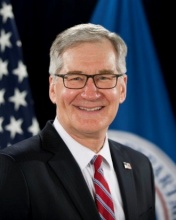
People, procurement top challenges for DHS’ future, execs and industry say
The Homeland Security Department's struggles to recruit, retain and develop top talent, as well as its challenges in fostering working industry relationships, will...
People and procurement should be the biggest priorities for the Homeland Security Department, as it enters the upcoming presidential transition and it approaches its 15th anniversary as an agency, according to a survey of DHS and industry executives.
Finding, recruiting, retaining and developing personnel into future DHS leaders is a major concern for the homeland security enterprise in the future, as is improving the department’s often fractured relationship with industry.
They’re perpetual challenges for DHS, but ones that the Homeland Security and Defense Business Council say are especially crucial in the coming years.
The Council published the first of its five-year 20/20 outlook on the department in 2015, when it focused on Secretary Jeh Johnson’s Unity of Effort initiative. The Council and Grant Thornton this year collected opinions from more than 100 current and former leaders at DHS and other organizations whose work intersects with the department’s mission on the entire homeland security enterprise.
Negative dialogue about the federal workforce in the press and on Capitol Hill has been “detrimental” to DHS, respondents said, and it’s inhibiting the department’s image, morale and ability to attract the right talent.
It’s a challenge Customs and Border Protection experienced as well.
CBP is at about 93 percent of its authorized workforce strength, said Kevin McAleenan, deputy CBP commissioner during a Dec. 1 Homeland Security and Defense Business Council panel discussion in Washington. But that’s not good enough, he said.
CBP spent the past year intently focused on whittling down the time it takes to a hire new talent. In the past, it took more than 400 days to bring on a new employee, McAleenan said.
Like many agencies, CBP found that it was losing out on top talent and qualified veterans leaving the service, as the background investigation process and new polygraph requirement made the time to hire too long.
“We’re asking people to take entry-level jobs often in remote areas away from where they’re from,” McAleenan said. “That’s a very big step. We’re also in an environment where there’s very low unemployment, and not everyone feels the same way they did about law enforcement the way they did a few years ago. We’re trying to differentiate what we do.”
The agency condensed its 12-step hiring process into measurable segments that it can complete more quickly, McAleenan said.
“We’re communicating with email and text now instead of writing [applicants] letters to talk about their status and our process. We’ve gotten the time to hire down 170 days. Six months … is now in the reasonable phase, but we want to continue to dial that in.”
Better communication for better acquisition
Improving the procurement process is also a key challenge for DHS in 2017. Industry last year expressed a deep-seated frustration in its working relationship with the department.
“Acquisition is still largely broken,” said Phil Kangas, principal on border and maritime security at Grant Thornton. “Communication is so important, communication early in the process, early in the requirement definition process, so the buyer ultimately understands the art of the possible and all the things that are available to them from industry and that industry can be viewed as an open partner to that.”
The department has made a concerted effort to improve its relationship with industry over the past year, respondents said. And while DHS leadership has certainly said it’s open and encourages industry collaboration, that message hasn’t yet made its way down to the front line operators, Kangasa said.
But more respondents this year indicated that industry played a critical role to DHS’ ability to achieve its mission. About 94 percent acknowledged industry’s role in 2016, compared to 74 percent in 2015.
For CBP, improving its relationship with industry is also a priority. McAleenan said his agency reorganized its acquisition oversight.
“We have asked our chief acquisition executive to really take an agencywide look at all of our major programs and intervene and support at each stage in the development, from the requirements piece through getting it approved, getting it funded and working on the procurement side,” he said. “We have devolved some of the key programs we were asking our CAE to dual-hat back to the operational components, so we can hold the chief of the Border Patrol or the executive assistant commissioner or field office accountable for delivery on the big things we’re doing.”
McAleenan also said his agency put a lot more effort on writing better RFIs and RFPs this year, and it will be a priority for CBP in the future.
Reauthorizing the DHS may be another priority for the department in the future. It hasn’t been reauthorized since Congress signed the Homeland Security Act of 2002. Reauthorizing the department may or may not be useful, the Council said. But what’s important, respondents said, is that DHS not lose the momentum it’s gained in the past several years.
“Certainly how the department is structured today, how it’s organized and how it’s funded is an important thing to review,” Kangas said. “Many of the focus groups felt very strongly, though, that a reorganization is probably the worst thing that you could do as a starting point, because momentum is so important. There’s been good work that’s been done to date, not only to create responsive organizations but to enable collaboration across the organizations.”
Copyright © 2025 Federal News Network. All rights reserved. This website is not intended for users located within the European Economic Area.
Nicole Ogrysko is a reporter for Federal News Network focusing on the federal workforce and federal pay and benefits.
Follow @nogryskoWFED




